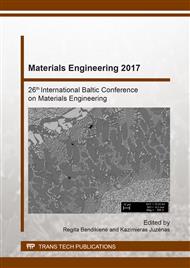p.132
p.139
p.145
p.151
p.157
p.162
p.167
p.172
p.177
Fatigue Crack Growth and Threshold Behavior of DMLS Ti6Al4V
Abstract:
Growth of long fatigue cracks in Ti6Al4V alloy manufactured by direct metal laser sintering (DMLS) was investigated. Two DMLS systems, EOSINT M270 and EOSINT M290, with different process parameters were used for production of CT specimens having three different orientations of crack propagation with respect to the DMLS build direction. The as-built specimens were stress relieved at 740 °C. The fatigue crack growth curve and the threshold values of the stress intensity factor for crack propagation were experimentally determined. It has been found that the chosen DMLS processing parameters and the used stress relieving procedure results in material exhibiting isotropic crack growth behavior, i.e. the crack growth was found to be independent of the DMLS build direction. The fatigue crack growth rates and the threshold values for the crack growth were compared with published results characterizing the as-built material and material after different post processing heat treatments.
Info:
Periodical:
Pages:
157-161
Citation:
Online since:
October 2017
Authors:
Price:
Сopyright:
© 2017 Trans Tech Publications Ltd. All Rights Reserved
Share:
Citation:


